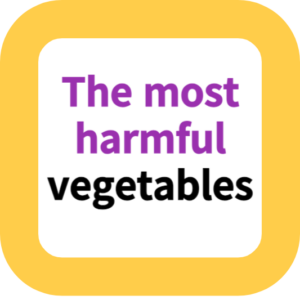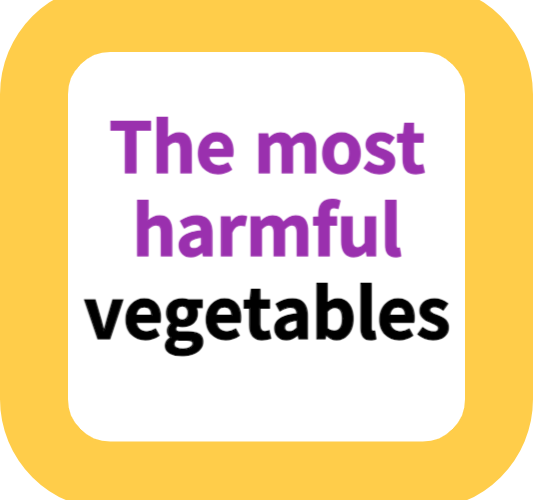The most harmful vegetables
Welcome to our latest blog post where we delve into the often overlooked aspect of vegetables – their potential health risks. Commonly hailed as pillars of a healthy diet, vegetables are packed with essential nutrients and fiber.
However, not all vegetables are entirely benign under certain circumstances. In this enlightening post, we explore the dual nature of various vegetables, from nightshade vegetables like tomatoes and potatoes, which contain solanine, to the lesser-known risks of rhubarb leaves, high in oxalic acid.
We also discuss the complexities of vegetables like spinach, Swiss chard, and bitter gourd, each with its unique benefits and potential drawbacks. Our goal is to provide a comprehensive understanding of these everyday foods, highlighting the importance of balance, moderation, and informed consumption in our diets.
Whether you’re a health enthusiast, a culinary explorer, or just curious about the food you eat, this post offers valuable insights into making safer and healthier food choices.
The most harmful vegetables

Introduction: The Dual Nature of Vegetables in Nutrition
Vegetables are universally recognized as fundamental elements of a nutritious diet, offering a rich source of vitamins, minerals, and dietary fiber. However, this positive reputation doesn’t entirely exempt them from having potential drawbacks.
In certain contexts or when consumed inappropriately, some vegetables can present health risks. This nuanced understanding is crucial for individuals who aim to make informed and healthy dietary choices.
Nightshade Vegetables: A Balancing Act of Benefits and Risks
Nightshade vegetables, such as tomatoes, potatoes, eggplants, and peppers, are staples in many diets, valued for their flavor and nutritional benefits. However, they contain solanine, a naturally occurring chemical that, in large quantities, can be toxic.
Symptoms of solanine poisoning include gastrointestinal distress like nausea, vomiting, and diarrhea. While the concentration of solanine in these vegetables is typically low enough to be safe for the majority of people, individuals with sensitivities or who consume them in large amounts should exercise caution.
Rhubarb Leaves: The Hidden Danger in a Culinary Favorite
Rhubarb, widely used in desserts for its tart stalks, harbors a lesser-known danger in its leaves. The leaves contain oxalic acid in concentrations high enough to cause serious health problems, including kidney failure.
This stark contrast between the edible stalks and toxic leaves of the rhubarb plant underscores the importance of thorough knowledge and careful preparation in the consumption of certain vegetables.
Spinach and Swiss Chard: Nutritious Yet Potentially Problematic
Spinach and Swiss chard are celebrated for their nutritional value, being rich in vitamins and minerals. However, their high oxalic acid content can interfere with the absorption of calcium and other minerals.
This is especially pertinent for individuals prone to kidney stones or with existing kidney problems. While these vegetables are safe for most people when consumed in moderation, those with specific health conditions should monitor their intake closely.
Bitter Gourd: A Double-Edged Sword in Diabetes Management
Bitter gourd, also known as bitter melon, is often lauded for its ability to lower blood sugar levels, making it a popular vegetable in managing diabetes.
However, its active compound, charantin, can lead to dangerously low blood sugar levels if consumed excessively. This highlights the importance of balancing the benefits with potential risks, particularly in the context of medicinal foods.
Fiddlehead Ferns: A Delicacy with a Toxic Twist
Fiddlehead ferns are a delicacy in certain cuisines but come with a caveat. They contain thiaminase, a toxin that depletes vitamin B1 (thiamine) in the body, leading to adverse effects such as nausea, vomiting, and dizziness. This makes proper preparation, including thorough cooking, essential for their safe consumption.
Cassava: A Staple with a Hidden Hazard
Cassava, a primary carbohydrate source in many regions, contains cyanide compounds that can be toxic. Proper processing and cooking are crucial to eliminate these toxins, showcasing the importance of traditional knowledge and culinary practices in ensuring the safety of staple foods.
Seeds and Nuts: Small but Significant Risks
While not typically considered vegetables, seeds of apples, cherries, and apricots, along with cashews, present risks that are often overlooked. These seeds contain amygdalin, which can produce cyanide in the digestive system.
Cashews, in their raw state, are covered with anacardic acid, which is toxic and irritating. Awareness and proper handling of these foods are essential to avoid potential health hazards.
Conclusion: Understanding the Complexities of Vegetable Safety
The consumption of vegetables is a key component of a healthy diet, but it’s essential to recognize that even seemingly innocuous foods can carry risks under certain conditions.
Understanding the potential adverse effects of certain vegetables, especially for those with specific health conditions, allergies, or sensitivities, is crucial.
A balanced and varied diet, along with informed choices and proper food preparation, is the best approach to harnessing the nutritional benefits of vegetables while minimizing potential risks. For personalized dietary advice, consultation with healthcare professionals or registered dietitians is always recommended.
